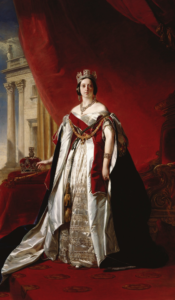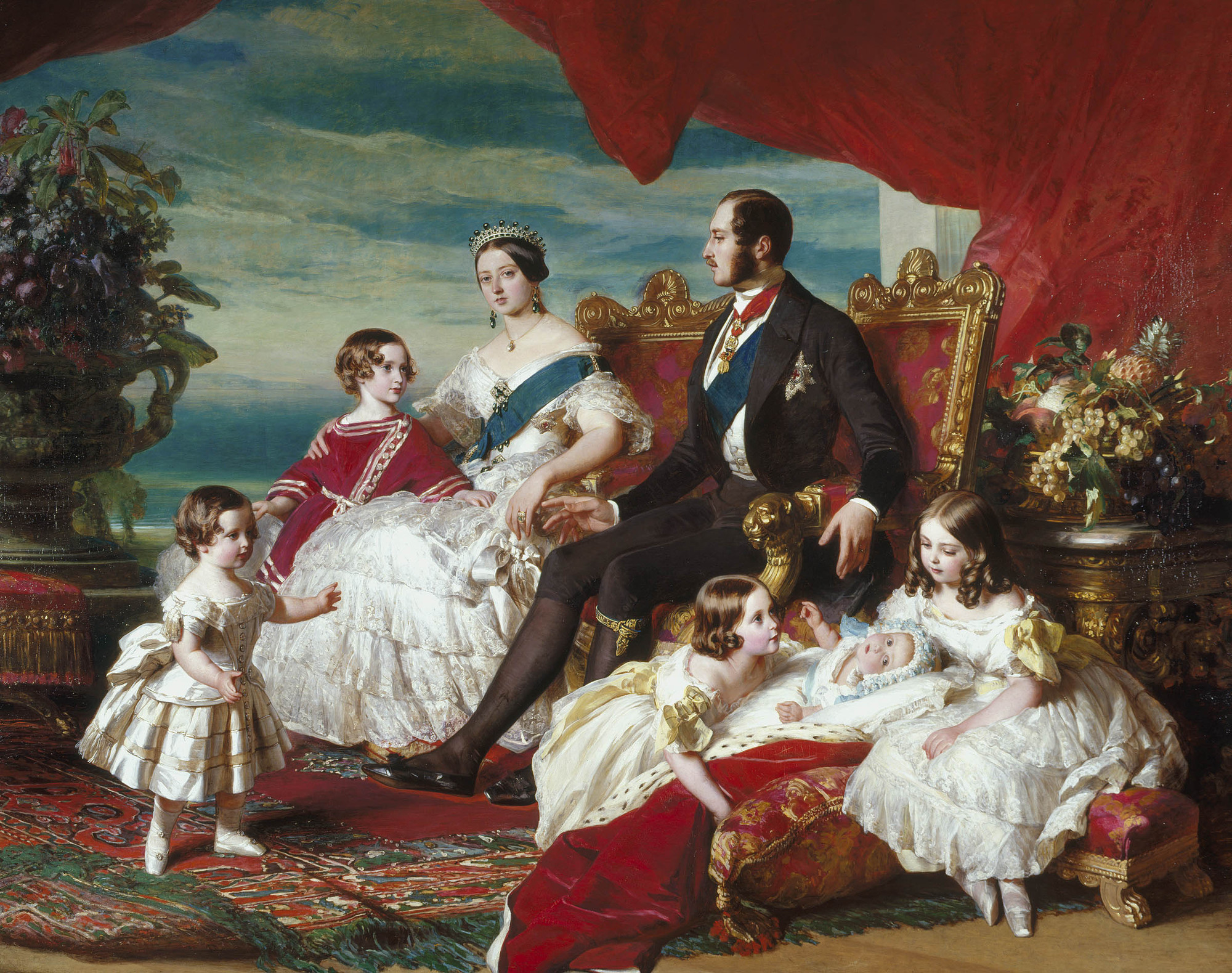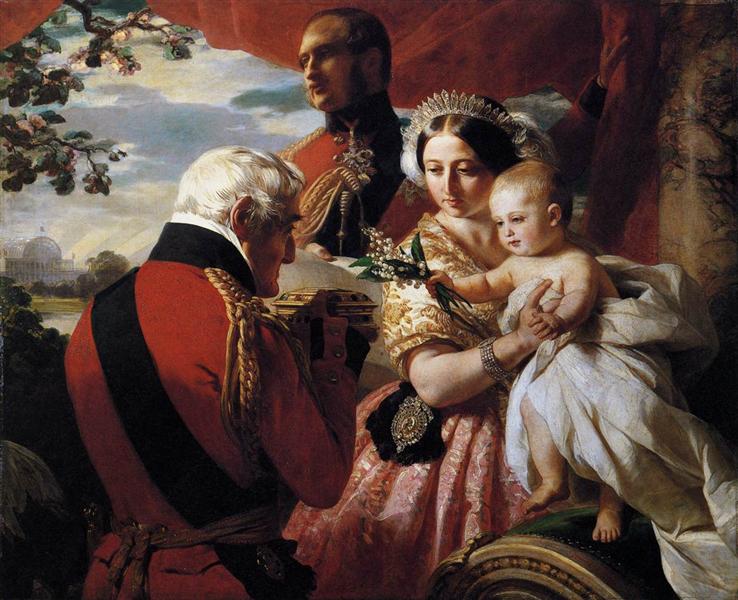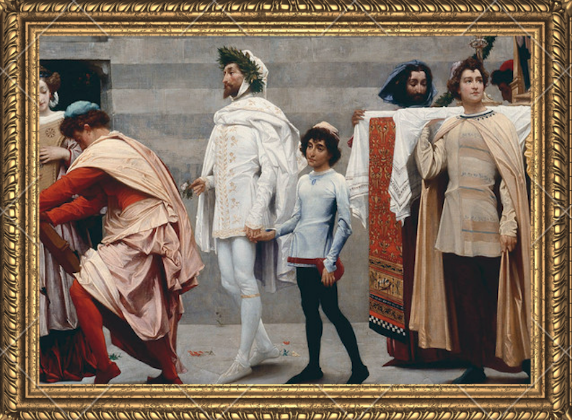Section 3: Victoria and Albert’s Cimabue
“There was a very big picture by a man called Leighton, his 1st attempt, at the age of 20… It is a beautiful painting, quite reminding one of a Paul Veronese, so bright and full of light. Albert was enchanted with it — so much so that he made me buy it. The young man’s father said that his future career in life would depend on the success of this picture.”[74]
-Queen Victoria in her journal, 1855

Figure 11. Franz Winterhalter, Queen Victoria (1819-1901), 1843, oil on canvas, 107 x 63 in, Windsor Castle.
The timing of the royals’ purchase—in the wake of the Europe-wide revolutions of 1848—is also crucial to understanding the political symbolism of this painting for them. In retrospect, we can see that the Victorian era was a period of relative peace and stability as well as economic prosperity. In the 1850s, though, it was not clear that this would be the case: the outbreak of revolution in France in February 1848 not only toppled the July Monarchy, but threatened the very institution of the monarchy. Inspired by France’s revolutionary demand for democracy, 1848 saw an outbreak of agitation and upheavals in several other European countries, including Germany, Switzerland, Austria, Hungary, and Italy. In Germany, republicanism was inspired by the events in France as well as American democracy; there were copies of the United States Constitution to be found in bookstores, in the street, and in a book entitled Das Staats Lexikon, which contained essays on the Constitution.[75] This German aim for democracy took a more violent turn, with antiestablishment forces gathering in protest in the streets. Similar democratic measures were taken in Switzerland, and a Swiss Constitution went into effect in 1848.[76] In Hungary, many sought for independence from Austrian absolutism, which resulted in a battle between Hungarian revolutionaries and the Austrian army.[77] In Italy, Italian nationalists and intellectuals organized several revolts throughout the course of 1848 in opposition of the dominant Austrian Hapsburg rule.
Though Victoria’s reign remained intact, the spirit of 1848 deeply affected political sentiment within the United Kingdom. In the immediate aftermath of the February 1848 revolution, the Illustrated London News predicted that Britain would join the revolutionary cause, arguing that “the coercive system of government”—i.e., monarchy—would be ended quietly in some places, and forcefully in others.[78] British writer Charles Greville emphasized the effect that the unrest in France would have on the rest of Europe, stating that “the whole world is influenced by all that is done in Paris.”[79] A conservative Member of Parliament, Richard Monckton Milnes, also believed that the French democratic system would exercise a strong influence on Britain.[80] As he wrote in a letter to the Marquis of Lansdowne in 1849,
“It is not likely, unless France should become the scene of misfortunes which we have no reason to anticipate, and which we should most seriously deplore, that the English people will remain unaffected by the extension to all citizens of political rights in a country with which we are physically so closely connected, and whose moral influences over other nations have always been remarkable: and for this we must be prepared.”[81]
While this did not come to pass, some small scale rebellions took place, including Chartist demonstrations in London in February and April of 1848.[82] Influenced by the French Revolutions of the previous half-century, Chartism was a working-class movement for parliamentary reform, which proposed a number of institutional political changes, such as universal suffrage and annually elected parliament members.[83] The Chartists openly opposed the monarchy and organized demonstrations against Victoria’s coronation and marriage.[84] Two years after 1848, revolution in Britain still seemed possible to the historian and essayist Thomas Carlyle, when he wrote that
“…universal democracy… has declared itself as the inevitable fact of the days in which we live… and here, in England, though we object to it resolutely in the form of street barricades and insurrectionary pikes, and decidedly will not open doors to it on those terms, the tramp of its million feet is in all streets and thoroughfares, the sound of its bewildered thousandfold voices in all writings and speakings, in all thinking and activities of men…”[85]
Though Carlyle assumed that violent unrest was anathema to the British, he believed that revolutionary ideals held wide appeal, and insinuated that democratic reform of some kind was inevitable.
Multiple disruptive events also marked the first two decades of Victoria’s reign. In Britain, the London Water Crises of 1831-2, 1848-49 and 1853-54 brought outbreaks of cholera, frequent water shortages, and discontent with London water supply companies.[86] The Irish Famine of 1845-52 strained the relationship between the British government and the Irish people, and led to Victoria’s unsavory nickname, “The Famine Queen.” A group of radical republicans, led by William Smith O’Brien, aimed to enflame revolution in Ireland after the British Parliament passed the “Treason Felony Act” in 1848, which was enacted to protect the Queen and the crown, and punished those who attempted to rebel. While not a large movement, the rebellion resulted in fatal shootings between police forces and Irish rebels. During this period, several territories within the British Empire also began to seek autonomy. In 1850, Britain granted Australia self-governing powers, as a result of demands for local self-governance. The New Zealand Wars of 1845-72, fought between British forces and indigenous Maori peoples, were caused by conflicts over land ownership, sovereignty, and resistance to British imperial expansion.[87] Similar struggles ensued in India between the Sikh Empire and the British East India Company in the tumultuous Anglo-Sikh Wars of 1845-46, 1848-49,1847-1850, 1857, and 1857-62. Initiated by the death of Sikh ruler Ranjit Singh, who had maintained a friendly relationship with the British, the East India Company took advantage of the power struggles following his death to enact a series of aggressive annexations throughout India.[88] The British officially declared war in 1845, and following the Second Anglo-Sikh War, in 1849, Britain annexed the Panjab state and maintained its authority and influence in India.[89] Another British imperial altercation of the nineteenth century was the Anglo-Afghan war of 1839-42, which began when the British Army strived to remove ruler Dost Mohammed Khan (1793-1842) and hand it over to Shah Shujah (1785-1842), who held a pro-British stance.[90] This change, along with British residence in the country, fueled resentment for the British in Afghanistan, and not long after, war had broken. Canada also took part in rebellions against British authority; in 1837-8, inspired by American democracy, Canadian revolutionaries resisted British control.[91] When we view these developments in totality, it is easy to see that Victoria’s hold on power appeared far less secure in the 1850s than they do in retrospect.
As a female monarch, moreover, Victoria had to address concerns about her own fitness to rule. In 1837, when she acceded to the throne as a young, unmarried woman, Lord John Russell, a member of her first cabinet, delivered in a speech in Stroud, England, in which he noted that
“We have had glorious female reigns. Those of Elizabeth and Anne led to great [military] victories. Let us now hope that we are going to have a female reign illustrious in its deeds of peace–an Elizabeth without her tyranny, an Anne without her weakness.”[92]
Russell’s statement encapsulated popular apprehensions about Victoria’s ability to lead the nation, even as he aimed to reassure his audience by allusion to her illustrious female predecessors. Skepticism about the young Queen’s authority was arguably surpassed by suspicion of her German-born consort, Albert, who received a decidedly unfriendly reception by the English public after their marriage in 1840. Widespread anti-German sentiment, occasioned skepticism about his commitment to the nation and fears that his influence may thwart British influence abroad.[93]
In the face of this resistance, the royal couple showed themselves to be astute in the management of their public image. Victoria cultivated an image of herself as a dutiful wife and doting mother; not only did this image conform to contemporary ideals of bourgeois femininity, but it also supported her efforts to project an aura of stability onto her reign. Through the large number of representations of her that circulated in poems, prints, and songs, Victoria achieved celebrity status.[94] These images allowed for a widespread intimate feeling of connection with, and pride in, the fashionable young Queen. The periodical Figaro in London commented on this dynamic:
“If it be true that ‘all the world’s a stage’, we suppose that Kings and Queens must be tip-top performers: stars engaged at heavy salaries, to play the leading business of this terrestrial hemisphere, Victoria has come out, in the character not only of a lady actress, but as a manageress on her own account…”[95]
As this passage suggests, the British public was well aware of the machinations behind the image of the Queen and the royal family; Figaro parodied the excessive number of stories celebrating her virtue and charisma in their column “Queeniania.”[96] Similarly, the Spectator commented on her efforts to align herself more closely with the public through various civic and charitable activities, and made connections between the influence of the press and Victoria’s desire to occupy a position of a populist figurehead.[97]
 Figure 12. Franz Winterhalter, The Royal Famiily in 1846, oil on canvas, 98 x 125 in, Buckingham Palace.
Figure 12. Franz Winterhalter, The Royal Famiily in 1846, oil on canvas, 98 x 125 in, Buckingham Palace.
Victoria’s image was constructed not solely through her media representation, but also through portraits of herself she commissioned throughout her reign. Many of her early portraits represented the Queen as youthful, domestic, or having regal authority.[98] Concurrent with her interests in painting, she believed a good portrait to possess accurate detail and an enhancement of the depicted subject.[99] Because of her admiration for specificity in painting, most of the portraits she had painted bear strong narrative, scenic and pictorial properties. She was often pictured in a state of contemplation, demonstrating assuredness, drama, bourgeois values, domesticity, and tranquility. One such portrait exemplifies her desired public persona, Franz Xaver Winterhalter’s painting Queen Victoria (1843; Figure 11). In the portrait, Victoria stands in the center of the composition on a regal red carpet, in the background we see the corner of Buckingham Palace. She wears George IV’s Diamond Diadem and a necklace made from Turkish diamonds given by Sultan Mahmúd in 1838. Beside her, we see the Imperial State crown and her scepter. Her stance is imposing and elegant as she looks intimidatingly towards the viewer. In her journal, she wrote that it ‘looked splendid,’ and that it captured an impressive likeness, a trait she greatly admired in painting.[100] The work captures many qualities which would benefit her image: she looks assured, stoic and regal, and manifests the bourgeois tastes of the royals. Additionally, the work captures a sense of her efforts in creating friendly relations with other nations, demonstrated through her gifted necklace. Another work by Winterhalter, entitled The Royal Family in 1846 (Figure 12), presents Victoria as both sovereign and mother. In the work, she, Albert, and their five children sit in the center, in a setting similar to the single portrait: in a room with red carpeting in front of a blue sky. While the couple still appears serious and stately, the work emphasizes Victoria’s role as nurturer to her family and, by extension, as a mother-figure for the British public.
In addition to portrait commissions, Victoria and Albert engaged in a number of cultural activities that seem designed to cement their image as modern, enlightened monarchs. In the 1840s, Albert became president of the Royal Fine Arts Commission, which led to the redecoration of the rebuilt Houses of Parliament. In 1843, he was elected President of the Society of Arts, which prompted the creation of the Great Exhibition.[101] But his most ambitious project was the Great Exhibition of 1851. Prince Albert suggested that the Great Exhibition would be created for three reasons: exhibition, competition, encouragement.[102] The event was intended to spur interest in technical and industrial education; to promote free trade between European nations; to increase British nationalism, and to boost imperial self-confidence. Housed in the purpose-built Crystal Palace in Hyde Park, it displayed nearly 100,000 exhibits from around the world (Figure 13).[103] Organized into four categories– Raw Materials, Machinery and Invention, Manufacture and Sculpture and Plastic Arts– half of the exhibition was devoted to Britain and half from countries in and outside of the British Empire. Notable objects from the British exhibits included iron ores, model homes, displays of industrial cotton production, porcelain, hydraulic presses, and fabrics. In the international displays, one could find exotic imperial objects such as woodcarvings from Greece, revolvers from the United States, jewelry from India, insects from New Zealand, and furs from Canada.[104] Albert’s focus on industrialism in Britain was part of an effort to avoid political upheaval in Britain; with an economic expansion in industry, more jobs would be created in Britain, allowing the working class to be integrated into the liberal economy.[105]
That the Great Exhibition was also intended to burnish the royal couple’s reputation is borne out in their 1851 commission from Winterhalter of a family portrait entitled The First of May 1851 (Figure 14) to commemorate the birth of Prince Arthur, their third son, as well as the inauguration of the Great Exhibition. The painting depicts Victoria, Albert, and Arthur against the backdrop of the Crystal Palace, toward which Albert looks longingly over his shoulder. The work communicates both the importance of royal lineage emphasized through Arthur, and the Exhibition as Albert’s greatest success. The painting also features several symbolic elements related to the Renaissance revival: the work compositionally resembles an Adoration of the Magi scene, and Arthur’s illuminated crown recalls a halo. Both the Christological symbolism and the reference to Renaissance adoration paintings help to legitimize the royal family and to emphasize the stability of their reign.

Figure 13. The Great Exhibition, 1851.

Figure 14. Franz Winterhalter, The First of May, 1851, 1851, oil on canvas, 50.98 x 42 in, Royal Collection Trust.
Art collecting was another important way that Victoria and Albert communicated ideas about themselves to the public. We know much of Victoria’s own opinions about art due to her journal, which she kept from 1832 through 1901, and which is preserved in the Royal Archives at Windsor Castle, where she often vividly described the works she acquired.[106] They were proud of their collecting habits, and even went as far as to exhibit their collection publicly. In 1855 the barrister and publisher Samuel Carter Hall obtained permission from the couple to publish engravings of selections from their art collection in the periodical Art Union, where two paintings and one sculpture were published each month.[107] Victoria also lent works from the collection to every Royal Academy exhibition from 1838 on, and to the Royal Society of Arts from 1851 on.[108]
The couple’s purchase of Cimabue’s Celebrated Madonna underscores their emphasis on the collection of Medieval and Renaissance works: of the approximately 13,000 works they acquired, works from that period are among the most prevalent. Their acquisitions were facilitated through the assistance of the royal couple’s artistic advisor, Wilhelm Heinrich Ludwig Gruner, who in the years 1845-47 supplied Victoria and Albert with many Italian paintings through connections with art dealers in Italy.[109] Some other artists represented in the Royal Collection include Agnolo Gaddi, Verrochio, Fra Angelico, Giovanni Bellini, Benozzo Gozzoli, Antonello da Messina, Perugino, and Gentile da Fabriano.[110] We know that in 1846 Albert paid £190 for both a Duccio triptych and Madonna of Humility, attributed to Fra Angelico.[111] Many of the works purchased for Albert’s collection were hung at the Osborne House, Victoria and Albert’s summer home, and included Duccio’s Crucifixion and other Scenes, Bernado Daddi’s The Marriage of the Virgin, and several works associated with Raphael.[112] As with Cimabue’s Celebrated Madonna, Victoria and Albert purchased several works by modern artists in the style of Renaissance paintings, including like Scottish artist William Dyce’s 1845 painting The Madonna and Child and another work drawn from Vasari’s Lives, Johann Michael Wittmer’s Raphael’s First Sketch of ‘Madonna della Sedia’.[113]
Cimabue’s Celebrated Madonna was, therefore, a timely and important purchase that helped Victoria and Albert to connect the British monarchy with the cultural prestige of the Italian Renaissance. Victoria’s comments about the painting’s Venetian qualities suggest not only her knowledge of Italian art, but possibly of Ruskin’s paeans to the greatness of Venetian art and society. If so, then it seems highly plausible that she was aware of his belief that the emulation of the great principles of Venetian art could improve British society at large. More broadly, widely-held views of the Italian Renaissance encompassed many qualities that she may have wished to associate with herself and with Britain as a nation, including the cultivation of artistic greatness and a harmonious, ordered society. It would have been desirable for Victoria’s reign to be associated with such ideals. A painting that Ruskin had championed for its truth to nature had the power to become a positive symbol of Victoria’s reign.
